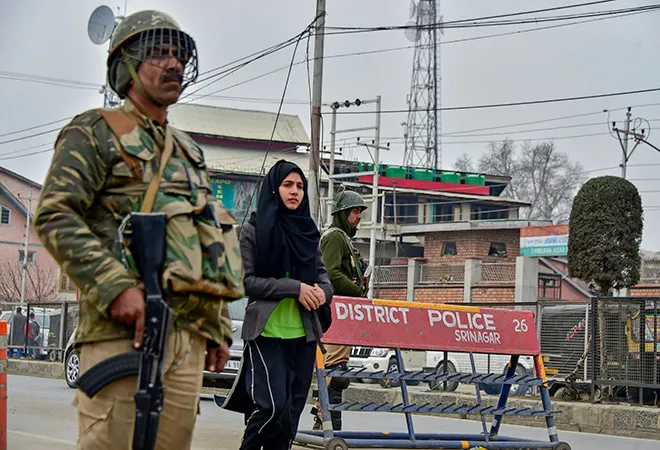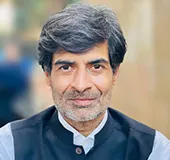
For close to four decades now, two of the most serious challenges to the Indian state have been the Khalistan movement in Punjab and the Islamist separatist movement in Jammu and Kashmir. India has confronted and responded to these movements using both security and political options, but clearly insufficiently. While the relative resilience of these movements can partly be attributed to unrelenting attempts by Pakistan to cause harm to India, there is also a domestic dimension that endures them. Feckless administration and opportunistic politics have harmed Kashmir over the past decade and is now playing out in Punjab as well.
In recent weeks, there have been three major developments that are redefining the contours of conflict in Kashmir. The first is the video-graphed execution of a teenager by Islamist terrorists. While the brutality by terrorists is not new to Kashmir, this was the first time that ISIS-style barbarism was publicised so brazenly.
The video caused widespread revulsion in Kashmir. Even political elements that had flirted with the issue of militancy and separatism saw this as a sign of the conflict moving into a dark space beyond their control. The reaction to the execution was therefore stark in its unequivocal condemnation. Nevertheless, has a die been cast?
Outside Kashmir, the imagery of this horrific execution would have redefined the conflict, certainly for Indians in other States. The idea of an ISIS-like phenomenon establishing itself in a part of India will convince most that there is now little scope for engaging with dissenting voices in the Valley. In other words, the space for negotiations and conversations in the minds of many may be reduced to an engagement defined by the use of hard power by the security forces and the barbarism of the terrorists. Advocates of dialogue and constructive engagement will find themselves in a difficult corner.
The second development is one that cements the perception that the political system of Kashmir is dysfunctional, corrupt and farcical. And it took only two tweets to achieve this.
The first was by the three immiscible ‘coalition’ partners – the NC, the PDP and the Congress – staking claim to form a government. The second tweet was by a rival contender who not only staked a claim to form the government but also announced that since the fax machine in the governor’s office wasn’t working, he had ‘WhatsApp’d’ his letter. Within minutes of these two tweets, the governor, who was ‘unreachable’, dissolved the State Assembly. The episode encapsulated the sordid and perverse state of politics in Kashmir. Every major political party was implicated in this failure, as were the minor players, who were willing pawns in this entire game.
The larger implication is that such episodes will only buttress the conviction in significant sections of society that a political solution is unlikely in Kashmir. Political solutions require credible political leadership, and that is absent in Kashmir.
The third defining, even egregious, image is that on the decadal anniversary of 26/11 – when Mumbai was attacked by a ‘veritable arm of the ISI ’ – the Government of India, in its wisdom, laid the foundation stone of the Kartarpur corridor.
If Islamabad has heretofore tried unsuccessfully to make Kashmir the pivot of the bilateral relationship, New Delhi has now unwittingly given Pakistan’s apparatchiks an opening to cultivate a small but radical section of the overseas Sikh community. What the Indian establishment sees as a pilgrim corridor is, in the eyes of the Pakistani deep state, a potential ‘Khalistan corridor’.
The third image, in many minds, will therefore be a conflation of Khalistan with Kashmir. The ISI, which has worked tirelessly to create a compact between the Kashmiri and Sikh diaspora in the West, will seize such an opportunity with alacrity. After all, the Kartarpur opening has facilitated Pakistan's ability to galvanise and stir trouble within a new constituency that now views Islamabad with rose-tinted glasses; as the deliverer of a cherished religious yearning.
Set against these three images unveiled in November, could one argue that India’s geopolitical and security paradigm has undergone a significant change?
Any miscalculation of the Indian side could have damaging and perhaps irreversible strategic and social consequences. In the Punjab of the 1980s, religious, political and civil society activists who opposed the Khalistanis were targeted. With the spectre of the past threatening to haunt Punjab again, can the Indian state summon the coherence and capacity to respond to a renewed problem? There is also an international dimension.
The Pakistanis have tried assiduously to incite and instigate Sikh communities in Canada, Germany, Australia, the US and the UK, with a view to forge a common front among the Kashmiri diaspora. These efforts have not received much traction.
But the Kartarpur ‘googly’ – the evocative description given by the Pakistani foreign minister to describe Imran Khan’s gambit – could bring about that ill-conceived “axis of disaffection”, creating problems for India, and ultimately Pakistan too.
Finally, there is the electoral dynamic that could unleash a transformation India can scarcely afford. The politics of polarisation in Jammu and Kashmir is leading darkly to the emergence of a Muslim Kashmir, a Hindu Jammu and a Buddhist Ladakh. One consequence of this is the demand often raised in Jammu and Ladakh for trifurcating the State. Driven almost entirely by the political playbook of different parties, this could intensify the de facto Islamification of Kashmir through the ballot, rather than the bullet. Instead of consolidating and managing different interests, democracy could well end up delivering the ethno-religious trifurcation of Jammu and Kashmir. Once the State loses the buffer that Jammu and Ladakh provide against Islamisation, by forcing the Kashmir Valley to accommodate other communities in the social, cultural and political domain, what will it mean for India’s capacity to retain Kashmir? This question can be interpreted both in alarmist and realist terms.
By opening the Kartarpur corridor, therefore, has India inadvertently walked into a Pakistani trap and allowed the potential juxtaposition of Khalistan and Kashmir? Pakistan is now presented with a chance to poison the 21st century aspirations of Indians in Jammu & Kashmir and Punjab with 20th century legacies of violence and sectarianism.
To be sure, problems in both States are owed in large part to poor governance and a squelching of legitimate, democratic demands by the Government in New Delhi. The conflation of both Ks, however, limits the agency of the Indian state to redress its own mistakes.
It is all very well to hope for the proverbial Berlin Wall between India and Pakistan to fall, but one must be careful not to be standing under the wall as it collapses.
The views expressed above belong to the author(s). ORF research and analyses now available on Telegram! Click here to access our curated content — blogs, longforms and interviews.




 PREV
PREV



